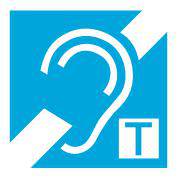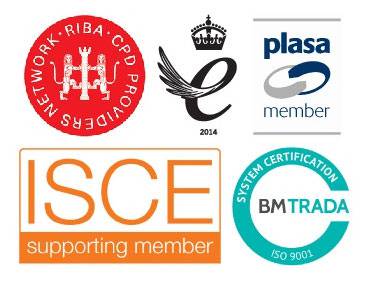
Ampetronic - Listen To The Difference
Established in 1987, Ampetronic offer a full range of induction loop / hearing loop systems and technologies, working as specialists in the field for 25 years.
Passionate advocates for technology solutions that improve the lives of those with hearing loss, Ampetronic design, manufacture and promote loop systems around the world.
What is an Induction Loop?
An Induction Loop, also known as a Hearing Loop or T-Loop, is an assistive listening system that provides access to facilities for those with a hearing impairment. It takes a sound source and transfers it directly to a hearing aid without background noise. The presence of an Induction Loop should always be indicated by the use of the sign on the right.
Over the last 25 years Hearing Loops have become the default assistive listening solution in Scandinavia, Europe and Australasia, and are now becoming increasing prevalent in America. Due to their benefits and ease of use, hard of hearing groups are mandating their installation in locations as diverse as taxis, kiosks, schools, houses of worship, concert halls and stadiums.
The number of users who can benefit from the system at one time is only limited by the number of people that can fit in the ‘looped’ area. Expensive receivers are not required and users don’t suffer the inconvenience of asking for and wearing a headset that marks them out as hard of hearing.
Hearing Loops are an inherently simple technology, but care should be taken (and professional advise sought) in their design, specification and installation so that the facility conforms to the International Standard and is of optimum benefit to the end user.

How does Induction Loop work?
1) Source
A sound source, such as a voice, TV, cinema sound system or other audio system is captured using a microphone or via a line out connection.
2) Signal
The sound signal is then connected to an Audio Induction Loop Amplifier which generates a current to pass the signal to an induction loop, usually made of copper tape or wire.
3) Transmission
The copper wire induction loop (usually) surrounds the area where the listening audience is located and produces a magnetic field.
4) T-Coil
The magnetic field is picked up by the Telecoil (or T-coil) inside the hearing aid of hearing impaired members of the audience.
5) Hearing
The hearing aid tailors the sound to the specific needs of the individual. Sound is delivered directly into the ear canal, without background noise and with the full spectrum of sound frequencies required for intelligibility.

About Ampetronic

Established in 1987, Ampetronic are innovators in the full range of induction loop / hearing loop systems and technologies, working as specialists in the field for 25 years. Passionate advocates for technology solutions that improve the lives of those with hearing loss, we design, manufacture and promote loop systems around the world.
We deliver a Genuine Benefit
We believe that if it will not help, don’t do it! Too many companies will sell boxes to customers that want to tick a compliance box, but in effect provide no benefit at all to the end user. We believe strongly that we are responsible for the reputation of loop systems, and will protect this by only selling where we believe the systems are put to appropriate use.
For example we do not advocate the use of portable desktop loops. While they can work, experience shows that a high proportion fail due to poor training or poor specification, or just lack of thought about what benefit is required.
We provide systems, not amplifiers
Loops are systems, the whole system matters. We offer help all those who specify, design, install, use and maintain loop systems. Any one weak part of the chain and the system will not work as it should resulting in the users will not get a benefit.
In particular we ensure our customers and the owners of loop systems understand the very important need for system planning, and good design of the loop layouts. We have the materials and design tools to support the planning activities of our customers or on their behalf.
Selling boxes is a sure way to end up with a large proportion of failing loops that do not meet operational standards.
Education, Education, Education
Loops can be simple, but also simple to get wrong. Far too many systems fail around the world through lack of basic knowledge and training.
We choose not to invest heavily in sales and marketing, but to invest in education at every level of the chain.

Frequently Asked Questions
Question: Why are Induction Loops needed?
Assistive listening devices are required for any environment where audible communication is integral to the space by both disability access legislation and building codes. They help the hearing impaired community who represent almost one in six people. Hearing Loops are the preferred assistive listening system by the hearing impaired as they are discreet (a user doesn’t have to ask for a headset and be visibly marked out as having a hearing impairment), hygienic (the user uses their own hearing aid rather than a headset that is owned by the facility and may not have been cleaned properly) and generate a hearing experience specific to each user’s needs (the user’s hearing aid is set up to deliver the volume and frequency range personally required by each individual).
Question: Isn’t this what hearing aids are for?
Hearing aids enhance sound in close conversational settings, or where there is little background noise or distance to the source. Many modern digital hearing aids can filter out a great deal of background noise; however this does not resolve the issue of distance between the sound source and the hearing aid user. A Hearing Loop magnetically transfers the sound from a microphone, TV or audio signal directly to hearing aids and cochlear implants without interference.
Question: How much does an Induction Loop cost?
The cost of an Induction Loop system is proportional to the size and complexity of the loop design, the associated amplifier(s) and the accessories required. A ‘fit-for-purpose’ retail/reception desk or home TV room loop should cost a few hundred pounds, whereas a professional system for a large venue may cost thousands proportional to the size of the venue and other audio visual equipment that may be installed. It is worth remembering that the cost of installing an Induction Loop in a medium size venue, such as a place of worship, will often be less than the cost a single user has paid for their professionally fitted hearing aids.
Question: How are they installed?
Induction Loop Systems are typically more expensive and time consuming to install than other assistive listening systems, however this cost is usually recouped over time as the systems are ‘fit and forget’ meaning that they require little maintenance and operation. Room Hearing Loops consist of two main components that are required for installation, the amplifier and the loop. The amplifier can either be placed in a rack with other audio visual equipment, or mounted to a wall in smaller venues. The loop itself is usually installed under carpets or wooden flooring and occasionally on architrave or in the ceiling. Small reception, or desk mounted loops are simpler as the loop often comes ready constructed for attachment.
Question: Can I just run some cable around the room?
In many cases it is possible to lay copper wire or tape around the edge of a room to form what is referred to as a ‘perimeter loop’, or sometimes even bury the cable in the floor outside the building. However this is often not the case as factors such as room size, shape, building construction and metal within nearby structures can all prevent a perimeter loop from being a feasible choice. Specialised computer programs now exist than can design a loop pattern comprised of many smaller loops, and sometimes more than one amplifier, which create a magnetic field that will operate to International Standards of conformity for field strength, background noise and frequency range. Please seek the advice of a qualified specifier before installing a system.
Question: Can I install the system myself?
Although the installation of an Induction Loop can be done by anyone with basic electrical knowledge, a field strength meter and certification documentation is required to test and commission the system to ensure it is working to the International Standard required by the user. If you do not have a field strength meter, or are unsure about how to fulfil the requirements of the standard it is recommended that a qualified installer is used – remember, if the Induction Loop isn’t working to the international Standard, then it isn’t working.
Question: Can Induction Loops be used in adjacent rooms?
The magnetic field produced by a standard Induction Loop design is not limited to the inside of the loop and can ‘spill’ into adjacent areas. This causes interference with loops close by and can also lead to security issues. Modern computer aided Loop designs can prevent this by designing systems that use multiple loops and amplifiers to create what is known as a ‘low spill’ system that doesn’t extend more than a few feet from the edge of the loop.
Question: Do all hearing aids have a telecoil?
The increasing popularity of Induction Loops has seen a steady increase in the inclusion of telecoils in hearing aids. At present just under 70% of hearing aid models on the market are fitted with them. This number is as high as 95% in countries where Hearing Loops are already established, and all new model cochlear implants now offer telecoils.
Question: Can people without hearing aids and/or telecoils use an Induction Loop?
All assistive listening systems, including hearing loops, can be used with portable receivers and headsets.
Question: Does interference for electrical equipment prevent the magnetic field from working?
In some cases, the environment may contain a significant amount of cabling or high voltage electricity making an Induction Loop either uneconomical or unsuitable. However, with the use of modern equipment and the correct design, these cases are now very limited.
Question: Don’t wireless technologies like Bluetooth offer an easier and less costly solution?
Wireless technologies are not suitable for assistive listening solutions in their current form as they cause significant battery drain and have a limited range. In the case of Bluetooth, as an example, the area cover is between 5-100 square meters (depending on type), the technology can only support the connection of up to 7 users at the same time and also requires the ‘pairing’ of devices in order to connect them.
Question: What sort of places can an Induction Loop be used in?
Although Hearing Loops have traditionally been used in places such as houses worship and conference rooms, advances in technology have allowed the spread of the technology to areas including: Stadiums, theatres, cinemas, concert halls, sports halls, courts, lecture halls, school classrooms, video conferencing suites, meeting rooms, museum exhibits, fairground rides, taxis, help points, nursing homes, domestic TV rooms, retail counters, receptions, transport stations, waiting rooms, boats, minibuses, cars and trains.

